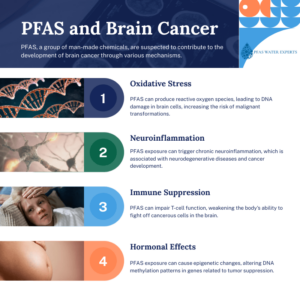Introduction
Per- and polyfluoroalkyl substances (PFAS), have been widely used in industrial, military, and consumer applications for decades. These persistent chemicals have been detected in drinking water, soil, food, and even human blood, raising serious concerns about their potential long-term health effects. While previous research has linked PFAS exposure to kidney, testicular, and liver cancers, studies now suggest a strong connection between PFAS and brain cancer.
Brain cancer, including glioblastoma, astrocytomas, and other central nervous system tumors, is one of the most aggressive forms of cancer. Given the neurological impact of PFAS exposure, researchers are investigating how these chemicals contribute to cancerous growths in brain tissues.
This article explores the latest scientific findings on the PFAS-brain cancer connection, the biological mechanisms involved, and what future research may reveal.
How PFAS Affects the Brain
PFAS chemicals have been shown to cross the blood-brain barrier, which serves as the body’s defense mechanism to protect the brain from harmful substances. Studies indicate that PFAS bioaccumulates in brain tissue, potentially disrupting neurological function and increasing the risk of tumor development.
1. PFAS Penetration of the Blood-Brain Barrier
- Research published in Toxicological Sciences (2021) demonstrated that long-chain PFAS compounds, such as PFOA and PFOS, accumulate in brain endothelial cells, weakening the protective barrier and allowing harmful substances to enter.
- A Journal of Neurochemistry (2022) study found that PFAS exposure leads to increased oxidative stress in the brain, a key factor in tumorigenesis.
2. Disrupting Cellular Pathways in the Brain
PFAS chemicals interfere with several cell signaling pathways that regulate cell growth and apoptosis (programmed cell death).
- p53 Tumor Suppressor Pathway: A 2023 study in Neuro-Oncology found that PFAS compounds inhibit the function of p53, a critical protein that prevents cells from becoming cancerous.
- MAPK and AKT Pathways: Disruptions in these pathways have been linked to increased glioblastoma cell proliferation and resistance to chemotherapy.
3. Hormonal and Immune System Effects
- PFAS chemicals act as endocrine disruptors, interfering with thyroid hormone levels and cortisol regulation, both of which are crucial for brain health.
- A 2022 study in Environmental Health Perspectives highlighted that immune suppression from PFAS exposure may contribute to the uncontrolled growth of brain tumor cells by reducing the body’s ability to detect and destroy them.
How PFAS May Contribute to Brain Cancer Development
1. Induction of Oxidative Stress and DNA Damage
- PFAS chemicals are known to generate reactive oxygen species (ROS), which cause DNA mutations in brain cells.
- A 2022 Molecular Oncology study found that chronic PFAS exposure leads to double-strand DNA breaks, increasing the risk of malignant transformations in glial cells.
2. Neuroinflammation and Immune Suppression
- Long-term PFAS exposure triggers chronic neuroinflammation, which has been implicated in both neurodegenerative diseases and cancer.
- PFAS may impair T-cell function, reducing the body’s ability to destroy cancerous cells in brain tissue.
3. Epigenetic Modifications and Cancer Progression
- PFAS exposure has been linked to epigenetic changes, including alterations in DNA methylation patterns in genes related to tumor suppression.
- A Cancer Epigenetics study (2023) showed that PFAS exposure silences tumor suppressor genes, increasing the likelihood of uncontrolled brain tumor growth.
Epidemiological Studies Linking PFAS to Brain Cancer
While research on PFAS and brain cancer is still developing, several key epidemiological studies provide compelling evidence of a connection:
1. Military and Firefighter Cohorts
- A 2023 Department of Defense (DoD) study found that military personnel exposed to PFAS-contaminated water at U.S. bases had a statistically higher incidence of glioblastoma compared to non-exposed service members.
- A Journal of Occupational Medicine study found that firefighters exposed to PFAS-containing firefighting foam (AFFF) had a two-fold increase in brain cancer risk over the general population.
2. Community-Based Research in Contaminated Areas
- In 2021, the Michigan PFAS Action Response Team (MPART) identified clusters of brain cancer cases in communities with high levels of PFAS contamination in drinking water.
- A 2022 study conducted by Harvard T.H. Chan School of Public Health examined residents in Cape Cod, Massachusetts, where elevated PFAS levels were linked to a higher rate of central nervous system tumors.
3. Case-Control Studies on Occupational Exposure
- Workers in chemical manufacturing plants producing PFAS compounds were found to have higher mortality rates from brain cancer, according to a National Institute for Occupational Safety and Health (NIOSH) 2022 study.
- A European study published in Environmental Research in 2023 confirmed increased brain tumor risk in PFAS-exposed industrial workers, suggesting an urgent need for regulatory intervention.
Regulatory and Public Health Implications
- The Environmental Protection Agency (EPA) has set stricter PFAS drinking water standards to limit exposure.
- The National Institutes of Health (NIH) has prioritized PFAS research funding, specifically in relation to neurological disorders and cancer.
- Ongoing litigation seeks compensation for communities and workers exposed to PFAS, emphasizing brain cancer cases among military veterans and firefighters.
Brain Cancer and the AFFF Lawsuit
The ongoing AFFF multi-district litigation (MDL) has recognized brain cancer as a qualified condition for compensation claims. Military personnel, firefighters, and individuals exposed to PFAS-contaminated water due to AFFF at military bases may be eligible to file a claim if they developed glioblastoma, astrocytomas, or other malignant brain tumors following prolonged PFAS exposure.
To build a viable case in the AFFF lawsuit, claimants must provide:
- Documented Exposure to AFFF or Contaminated Water: Military service records or employment history showing prolonged occupational exposure to AFFF firefighting foam.
- Medical Diagnosis of Brain Cancer: A confirmed diagnosis from an oncologist with pathology reports and imaging results.
- Scientific Evidence Linking PFAS to Brain Cancer: Legal teams are using peer-reviewed studies and expert testimony to demonstrate the connection between PFAS exposure and brain tumors.
- A Nexus Opinion from a Medical Professional: A written statement from a qualified medical expert affirming that the brain cancer diagnosis is “at least as likely as not” linked to PFAS exposure.
As lawsuits progress, settlements and jury verdicts may set precedents for PFAS-related brain cancer compensation. Individuals considering a claim can find more information through our online AFFF lawsuit portal.
PFAS Brain Cancer Lawsuit FAQs
Recommended Future Actions
- Expansion of long-term epidemiological studies to establish a clearer causal relationship.
- Development of biomarkers for early PFAS exposure detection in at-risk populations.
- Stronger workplace protections for firefighters, military personnel, and chemical industry workers.
- Increased regulatory action to phase out long-chain PFAS compounds and replace them with safer alternatives.
The growing evidence linking PFAS exposure and brain cancer is an area of increasing concern, particularly for military veterans, firefighters, and industrial workers exposed to these persistent chemicals.
As public awareness and scientific research expand, more stringent regulations and legal actions may help protect at-risk populations from further harm. In the meantime, individuals with known PFAS exposure should consider regular neurological screenings and take proactive steps to limit further contamination.






